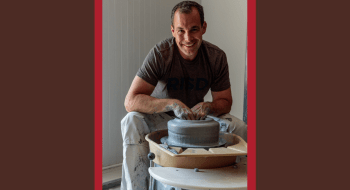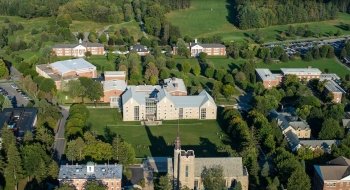
Message from the President
Every summer during my undergraduate years at St. Lawrence, I worked outdoors on public land doing maintenance, repair, and construction. Looking back, I wonder how I endured the intense heat of those days on a roof, a broken road, or an open field. My mother always said I would “fill out” someday, but I never did, perhaps owing to the narrow range of my unskilled labor, which cost me 10 pounds of weight in the summertime on a frame that could carry 10 the other way.

It was during those summers that I read Thomas Wolfe’s Look Homeward, Angel and You Can’t Go Home Again, the perfect literature for that moment of life, with its open-spigot language that college English departments avoided teaching, unless it was James Joyce. And yet, ironically, all the major literary figures of the 20th century apparently understood and passed through Wolfe’s stacked-up prose pages.
Tuberculosis—a global and ancient infection, slower moving than a pandemic, but with similar consequences—was in the near background of all Wolfe’s personal life and writing. He was extremely mindful of its meaning, a disease at the time without a known cure, with an insidious timer running against longevity, surely an impetus for every paragraph’s urgency.
It was sometimes called “the white plague,” and its literary victims included Keats, Shelley, Thoreau, the Brontë sisters, and Elizabeth Barrett Browning. Thomas Wolfe was most likely exposed at an early age at his mother’s boarding house in Asheville, North Carolina, where she gave lodging to TB patients seeking respite in the mountain air. He lived under its shadow presence for 20 years and died at age 38.
In the midst of our current experience with a deadly disease, if only in terms of the relentless emotional drain we share, there is perspective from the hand of Thomas Wolfe. He marveled at the human mind “in its mysterious powers of resilience, self-protection, and self-healing.” And then, as his signature line reports the ultimate strangeness of going back to a place or a memory, he pushes his audience beyond its instinctive homeward orientation, past the familiar rhythms and “forgotten faces.”
He proclaims a breakthrough realization that seems to me an essential transition for college students to achieve, especially now: “Unless an event completely shatters the order of one’s life, the mind, if it has youth and health and time enough, accepts the inevitable and gets itself ready for the next happening like a grimly dutiful American tourist who, on arriving at a new town, looks around him, takes his bearings, and says, ‘Well, where do I go from here?’”
The question “what next?” is not premature. It is now time to start the mind’s recovery with first thoughts about rebuilding our world. It has been sorely damaged, and even if it’s not the equivalent destruction of bombs in wartime, the moral interior of the world is suffering. Human lives are broken in ways unforeseen in our generation.
The vast “inevitable” demands acceptance. No one can be sure that what we have once known and enjoyed can ever be restored. So, we lament, but wonder, “How can the world be rebuilt?” This will be the main purpose in life that our students will have in front of them for an exceedingly long time.
We are witnessing more than the early consequences of pandemic disease and its uncertain terms of recovery. For a long time, the natural beauty and wealth of the world deteriorated, the imbalances of capital and labor increased, cities and institutions recklessly fractured, and the inspiration of decency and truth-telling were disregarded. The remainder of our lives should be devoted to works of reconstruction, many of them material in nature, others of the more intrinsic human values.
From a literature of antiquity there is a picture in my head of a work crew on scaffolding repairing the walls of a beloved city that had been torn apart over time. They are building “in such a way that each with one hand labored on the work and with the other held his weapon.” That’s a curious piece of toil underway, doing the precision of stone masonry with only one hand. It emphasizes a particular kind of moment in human experience that is not so much about creating something new as it is about fixing something basic.
We hear repeatedly that there must be an absolute necessity of creativity in our society, a word that has become a ready idol to be revered, certainly so in technology, communications, and education. Economists celebrate the idea of “creative destruction,” a pair of taut words that would warrant a smirk from Orwell. And yet, let’s be honest, creation is an extremely rare and difficult act. Most of us have no right to give our daily work and evolved ambition that conceit. Prophets of innovation are often overrated copyists.
The plain fact is that an extraordinary portion of the world’s energy and focus has always been spent in maintenance and repair rather than originality and creation. The process of rebuilding, including its grinder of drudgery, is its own high calling. The meaning of workers holding in one hand a mason’s trowel, but in the other a sword, suggests we will each have to face our task of reimagining our world without a single mind, but with a divided mind, one that maturely understands that there will be interruptions and diversions. There will be the constant challenge of doing two things at once, fighting off trouble with one hand and squaring the stones with the other. But the courses will eventually add up.
Laurentians, whether current or former citizens of our campus, are already asking, “Where do we go from here?” “Enter to learn, go forth to serve” are the words etched by the north door of Gunnison Memorial Chapel.
We each have stones to set in the hurting places, with time enough, and a mind to work in rebuilding human hopes. The world needs St. Lawrence.
—WLF



